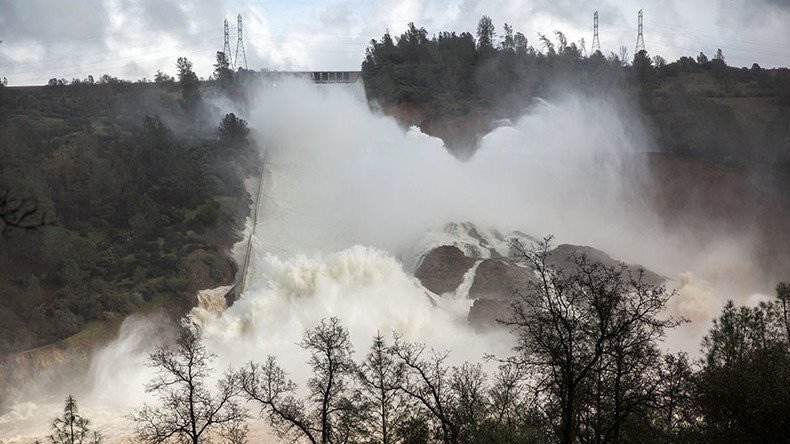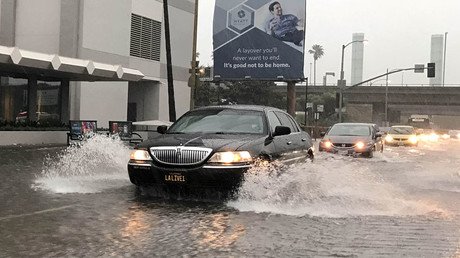Ecological threats loom amid rising Calif. reservoir, damaged spillway at tallest US dam

A damaged spillway that diverts overflow from a California reservoir has authorities preparing to use a forested emergency spill route if Lake Oroville keeps rising. A salmon hatchery below the dam is at risk, officials say.
Rising levels of Northern California's Lake Oroville, a reservoir contained by the Oroville Dam, the largest dam in the US, led to severe erosion of a paved spillway that helps divert overflow water into the Feather River behind the dam.
On Tuesday, a chunk of the spillway collapsed, sending mud and debris into the river, as officials with the California Department of Water Resources (DWR) temporarily ceased the overflow route to inspect the problem. Yet flows had to continue as the reservoir continued to rise. The section of collapsed spillway has grown to more than 200 feet wide and 30 feet deep, according to the San Francisco Chronicle. If the reservoir continues to balloon, authorities say they will have to use an emergency spillway, which is essentially a nearby wooded hillside.
As of now DWR is not expecting to use emergency spillway, but clearing debris as a contingency.
— CA - DWR (@CA_DWR) February 10, 2017
"DWR shut off flows temporarily to investigate but has resumed using the gated spillway channel in order to try to avoid having the lake rise to elevation 901 feet above sea level, the point at which water naturally flows over a concrete weir and down a wooded hillside," the DWR said in a statement Friday.
The DWR says the public is not currently at risk, as the US Army Corps of Engineers has said the main dam is sound.
"None of this emergency we have now is affecting the integrity of the dam itself," said Bill Croyle, deputy director of the DWR. "I think that’s important ... there’s no risk to the public."
Nevertheless, authorities have told residents near the Feather River to be prepared for a potential emergency evacuation, Reuters reported.
#Orovillespillway update #Friday morning. 65,000cfs release flowing out now. #Oroville#FeatherRiver@billhusa1@ChicoERpic.twitter.com/NjoBQneIDh
— bill husa (@billhusa1) February 10, 2017
More precipitation on Thursday pushed reservoir operators to increase flow to the eroded spillway from 40,000 cubic feet per second (cfs) to 65,000 cfs, DWR said.
"The higher flows further eroded the gated spillway channel, but not to a point that would compromise the integrity of the dam upstream," the department said. "DWR and many federal and state partners are monitoring the spillway erosion carefully and are prepared to ramp down flows if necessary."
#Lake#Oroville#Spillway#Update Thursday. Both sides have crumbled off. Dam road closed pic.twitter.com/hXqdAWfDkW
— bill husa (@billhusa1) February 9, 2017
Crews are currently clearing more than 50 acres of brush and debris along the hillside in order to limit what flows into the Feather River in case the emergency spillway is used, officials said, according to the Chronicle.
Take a look at the emergency #Spillway on the #OrovilleDam
— Dan Reidel (@danthephotog) February 10, 2017
Satellite image via @googleearthpic.twitter.com/BZLTz2TKgM
The DWR said the emergency spillway has not been used since the 770-foot Oroville Dam, a major source of water throughout the state, was constructed 48 years ago. Lake Oroville came within about a foot of the emergency track in January 1997, the agency said.
Meanwhile, the Feather River Fish Hatchery, the source of about seven million Chinook salmon and steelhead per season, has taken in severe water turbidity levels as a result of the overflow and damaged spillway. On Thursday, turbidity, or cloudiness, levels were about 40 times above normal, according to Harry Morse, spokesman for the California Department of Fish and Wildlife.
"This is just uncharted territory," Morse said, according to the Chronicle.
For fear of mass fish kills amid the debris- and mud-filled water flowing into the hatchery, state Fish and Wildlife crews have rushed to transport about four million baby salmon to a downstream hatchery that is safe from rapid inflows. An additional four million fish will have to remain at the hatchery, Morse said.
Crews worked Thursday in waist-deep muddy water to funnel baby fish to tanker trucks that would transport them downstream, according to the Sacramento Bee.
The hatchery is "very important" to California's salmon industry, said John McManus, executive director of the Golden Gate Salmon Association. Officials estimated that the hatchery raised between 63 percent and 76 percent of California's recreational and commercial ocean fish catches, respectively.
"The loss of hatchery-produced salmon from Feather River Hatchery would be a major blow to salmon fishermen in California," McManus said, the Sacramento Bee reported.
Use of the emergency spillway would only increase damage to the hatchery, Morse said.
Looks like salmon are the real losers here. (@michael_bodley has the latest on Oroville Dam's mess.) https://t.co/OdTcy2Z6AX
— Kurtis Alexander (@kurtisalexander) February 10, 2017
"This is a work in progress, and it has not been done before," he said of attempts to partially clear the hatchery, according to the Chronicle. "It’s ongoing as we speak."
Cal Fire units are among those helping to clear trees from the ravine in case the emergency spillway is used.















